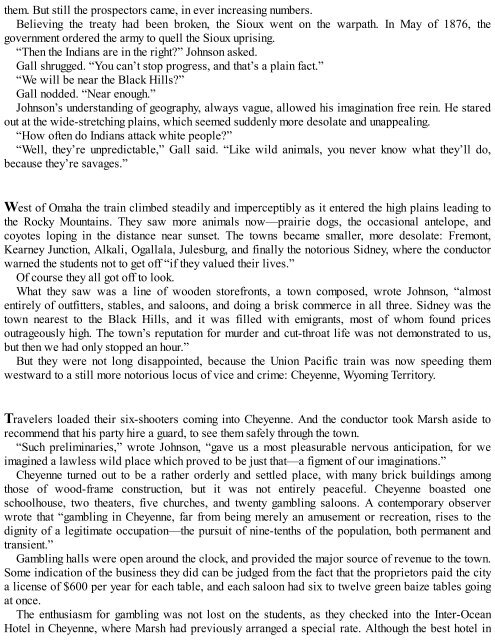Create successful ePaper yourself
Turn your PDF publications into a flip-book with our unique Google optimized e-Paper software.
them. But still the prospectors came, in ever increasing numbers.<br />
Believing the treaty had been broken, the Sioux went on the warpath. In May of 1876, the<br />
government ordered the army to quell the Sioux uprising.<br />
“Then the Indians are in the right?” Johnson asked.<br />
Gall shrugged. “You can’t stop progress, and that’s a plain fact.”<br />
“We will be near the Black Hills?”<br />
Gall nodded. “Near enough.”<br />
Johnson’s understanding of geography, always vague, allowed his imagination free rein. He stared<br />
out at the wide-stretching plains, which seemed suddenly more desolate and unappealing.<br />
“How often do Indians attack white people?”<br />
“Well, they’re unpredictable,” Gall said. “Like wild animals, you never know what they’ll do,<br />
because they’re savages.”<br />
West of Omaha the train climbed steadily and imperceptibly as it entered the high plains leading to<br />
the Rocky Mountains. They saw more animals now—prairie dogs, the occasional antelope, and<br />
coyotes loping in the distance near sunset. The towns became smaller, more desolate: Fremont,<br />
Kearney Junction, Alkali, Ogallala, Julesburg, and finally the notorious Sidney, where the conductor<br />
warned the students not to get off “if they valued their lives.”<br />
Of course they all got off to look.<br />
What they saw was a line of wooden storefronts, a town composed, wrote Johnson, “almost<br />
entirely of outfitters, stables, and saloons, and doing a brisk commerce in all three. Sidney was the<br />
town nearest to the Black Hills, and it was filled with emigrants, most of whom found prices<br />
outrageously high. The town’s reputation for murder and cut-throat life was not demonstrated to us,<br />
but then we had only stopped an hour.”<br />
But they were not long disappointed, because the Union Pacific train was now speeding them<br />
westward to a still more notorious locus of vice and crime: Cheyenne, Wyoming Territory.<br />
Travelers loaded their six-shooters coming into Cheyenne. And the conductor took Marsh aside to<br />
recommend that his party hire a guard, to see them safely through the town.<br />
“Such preliminaries,” wrote Johnson, “gave us a most pleasurable nervous anticipation, for we<br />
imagined a lawless wild place which proved to be just that—a figment of our imaginations.”<br />
Cheyenne turned out to be a rather orderly and settled place, with many brick buildings among<br />
those of wood-frame construction, but it was not entirely peaceful. Cheyenne boasted one<br />
schoolhouse, two theaters, five churches, and twenty gambling saloons. A contemporary observer<br />
wrote that “gambling in Cheyenne, far from being merely an amusement or recreation, rises to the<br />
dignity of a legitimate occupation—the pursuit of nine-tenths of the population, both permanent and<br />
transient.”<br />
Gambling halls were open around the clock, and provided the major source of revenue to the town.<br />
Some indication of the business they did can be judged from the fact that the proprietors paid the city<br />
a license of $600 per year for each table, and each saloon had six to twelve green baize tables going<br />
at once.<br />
The enthusiasm for gambling was not lost on the students, as they checked into the Inter-Ocean<br />
Hotel in Cheyenne, where Marsh had previously arranged a special rate. Although the best hotel in
















